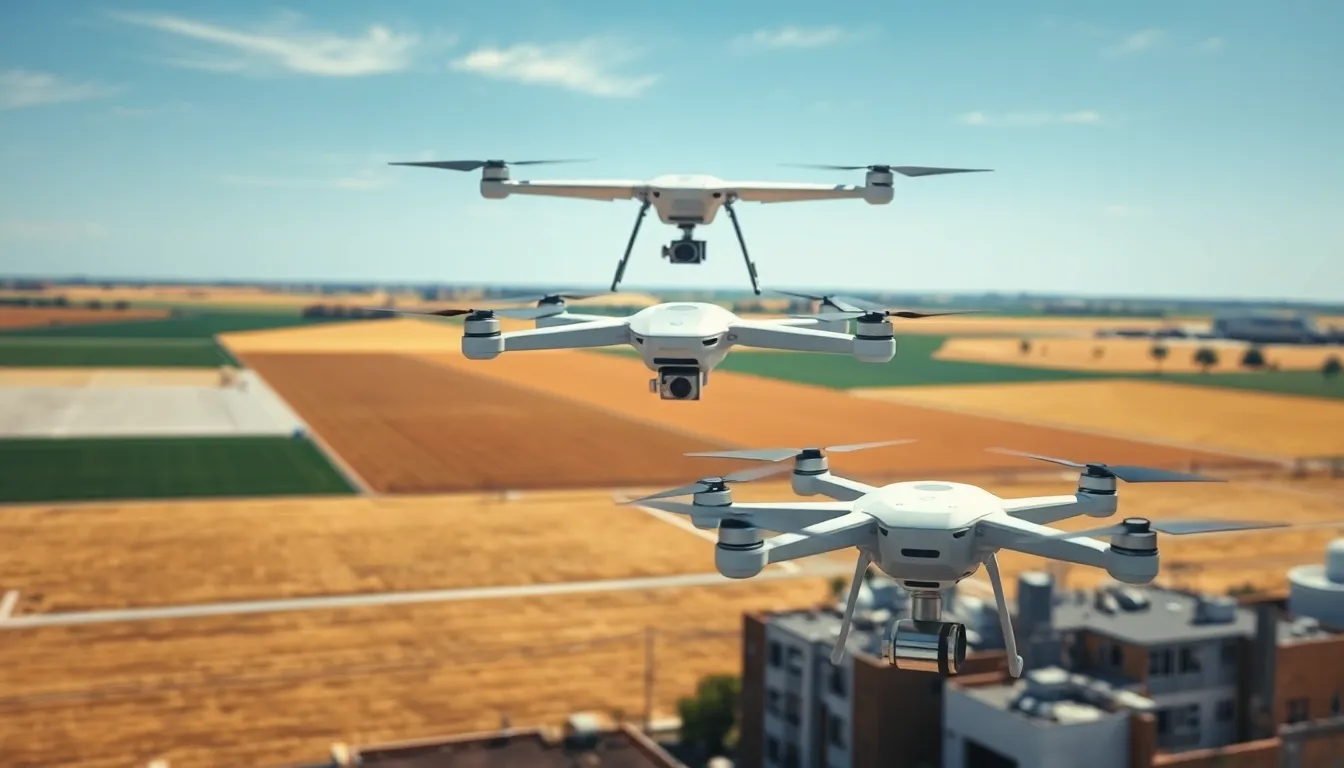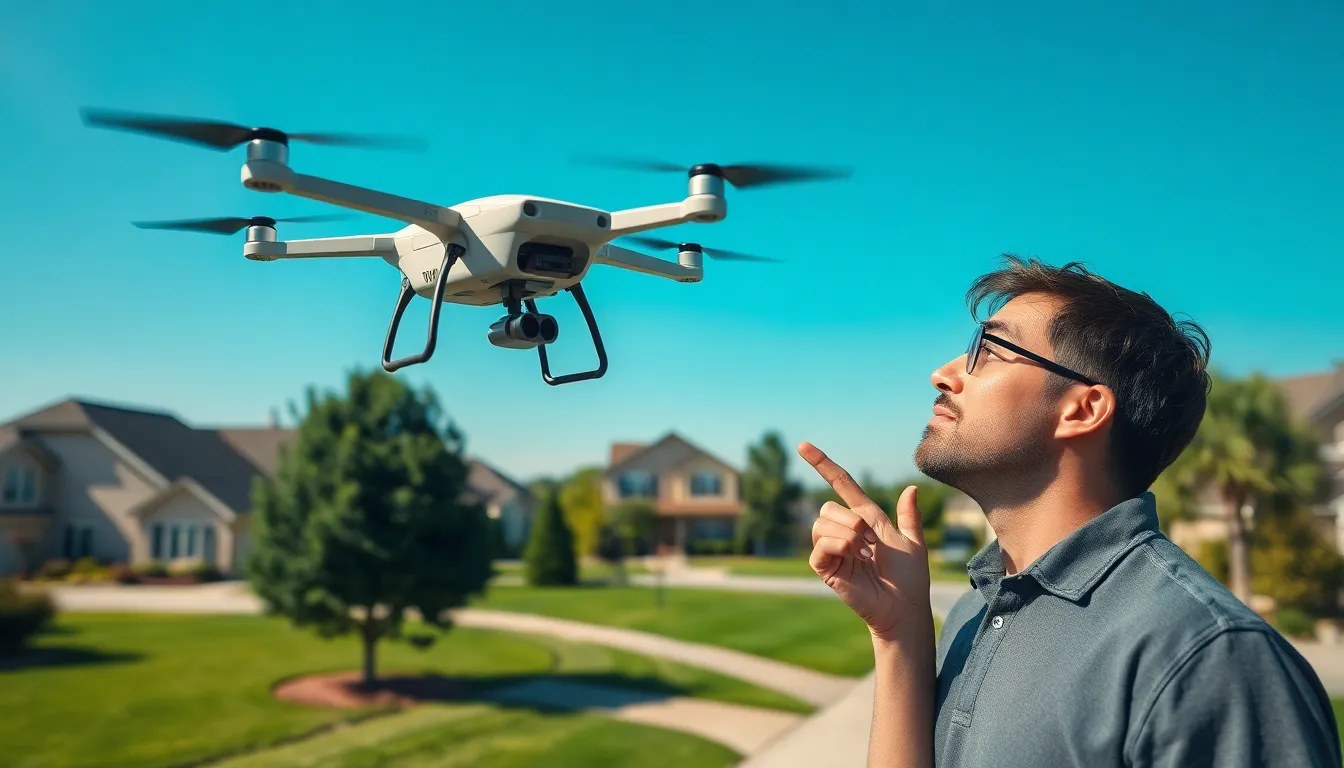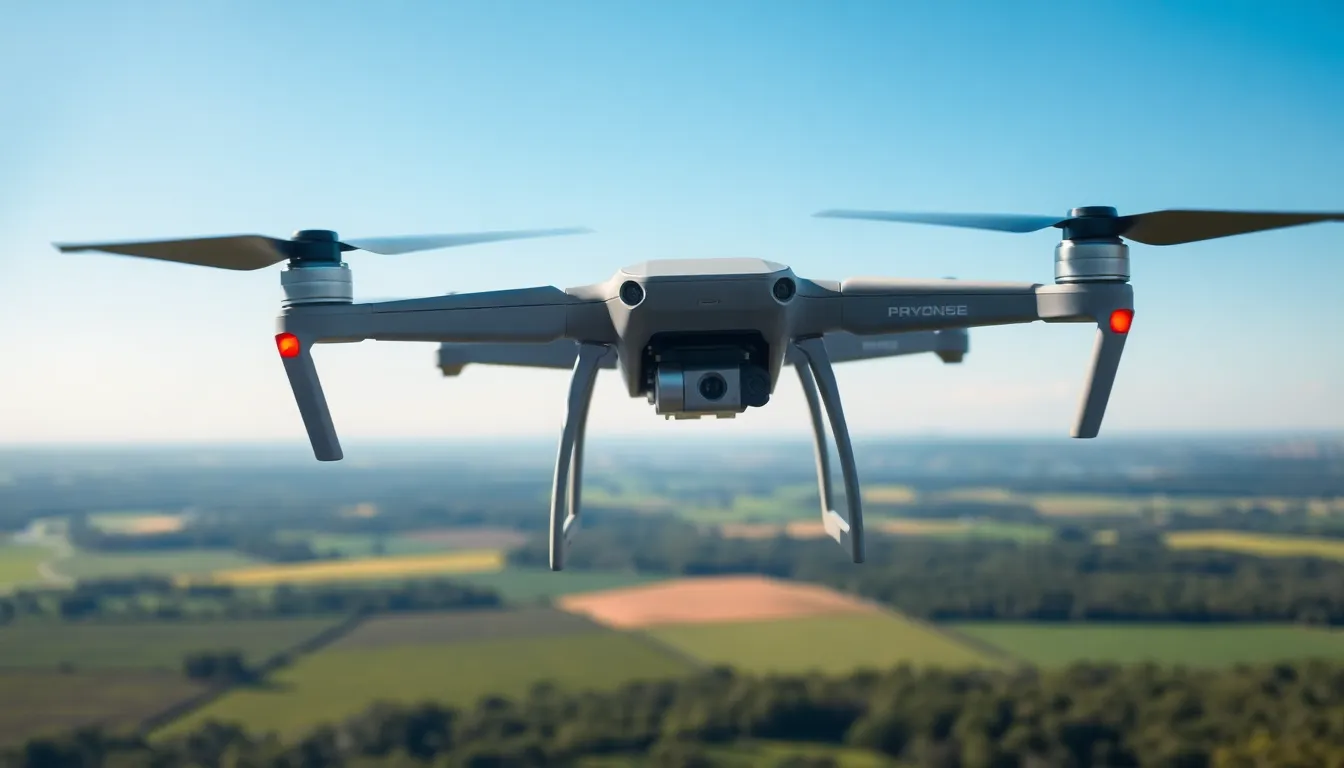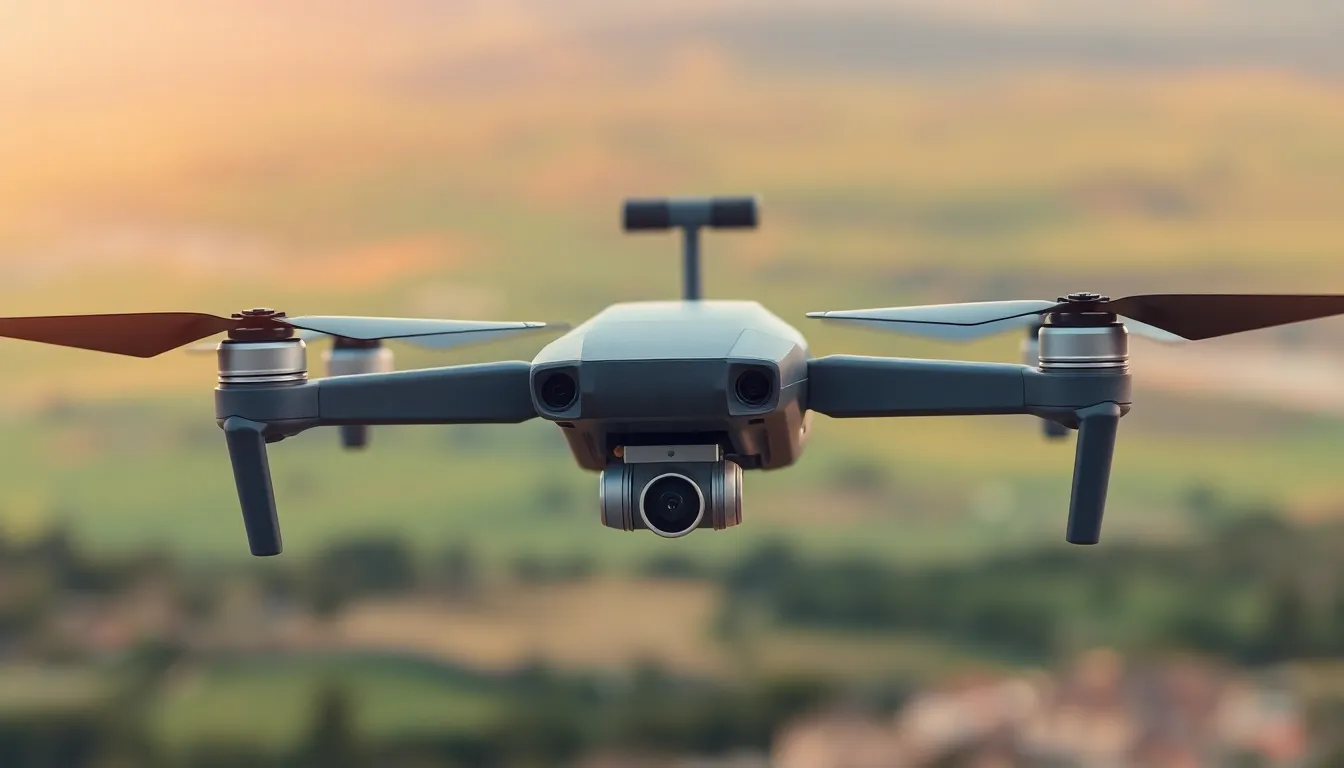Imagine a world where your pizza arrives faster than you can say “extra cheese.” Delivery drones are making this dream a reality, soaring through the skies to drop off your favorite goodies right at your doorstep. These high-tech marvels aren’t just for the tech-savvy; they’re revolutionizing how we think about convenience and speed in our daily lives.
Table of Contents
ToggleOverview Of Delivery Drones
Delivery drones represent a significant advancement in logistics and transportation. These unmanned aerial vehicles utilize cutting-edge technology to deliver packages efficiently. With their ability to bypass traffic congestion, they meet the increasing demand for rapid delivery services.
Various industries are exploring the implementation of drones. Retailers, food services, and healthcare sectors utilize drones to streamline shipping processes. For instance, restaurants are beginning to use drones for food delivery, enhancing convenience and reducing wait times for customers.
Technical capabilities emphasize the features of delivery drones. Equipped with GPS and obstacle avoidance systems, they ensure safe navigation in urban and rural areas. Many drones can carry payloads weighing up to 5 pounds, making them ideal for small to medium-sized deliveries.
Regulatory frameworks influence the deployment of delivery drones in commercial applications. The Federal Aviation Administration (FAA) has established guidelines to ensure safe operation. As regulations evolve, the integration of drones into the airspace is expanding, supporting broader acceptance within society.
Cost efficiency plays a significant role in the growth of drone delivery services. Businesses report reduced operational expenses and increased speed compared to traditional delivery methods. These savings benefit both consumers and companies, promoting widespread adoption.
Innovative companies are at the forefront of developing drone technology. Partnerships between tech firms and delivery services drive advancements in design and functionality. As competition intensifies, expectations for speed and reliability in delivery services also rise.
Overall, delivery drones are reshaping logistics by providing quick, cost-effective solutions. Their increasing presence in various sectors indicates a transformative shift in how goods are distributed.
Types Of Delivery Drones

Delivery drones come in various forms, each designed for specific tasks and environments. They play a crucial role in enhancing delivery efficiencies across industries.
Fixed-Wing Drones
Fixed-wing drones feature a wing structure similar to traditional aircraft, enabling them to glide efficiently. These drones excel in long-distance flights, often covering several miles without needing frequent recharges. They can transport payloads over 10 pounds, making them suitable for larger deliveries. Multiple industries, including agriculture and logistics, benefit from their extended ranges. Fixed-wing models require more space for takeoff and landing, placing them in environments free from obstructions, like wide-open fields. Their design enables better wind resistance, enhancing stability during transit.
Multirotor Drones
Multirotor drones, characterized by their vertical flight capability, utilize multiple rotors for lift and stability. They operate well in urban environments, offering precise landing capabilities. Payload capacities for multirotor models typically range from 1 to 5 pounds, making them ideal for small packages like food deliveries or medical supplies. Short distances define their operational strengths, favoring quick delivery times. These drones can maneuver easily in tight spaces, allowing them to bypass obstacles effectively. Industries such as food services and e-commerce leverage multirotor drones for rapid services, reinforcing the growing trend of drone usage in urban logistics.
Advantages Of Delivery Drones
Delivery drones present numerous benefits that enhance logistics and customer satisfaction. Their innovative use in various industries is rapidly changing delivery dynamics.
Speed And Efficiency
Drones achieve remarkable speed, often completing deliveries in under 30 minutes. This quick turnaround significantly improves customer satisfaction as people expect rapid service. Operating autonomously, drones bypass traffic congestion, delivering packages directly from point A to point B. Advanced GPS technology enables precise navigation, ensuring accuracy in deliveries. Increased battery efficiency in modern drones extends operational range while maintaining speed. Furthermore, businesses can process more orders in less time, optimizing overall service delivery.
Cost-Effectiveness
Delivery drones reduce operational costs for businesses. Utilizing drones often leads to decreased labor expenses, as fewer personnel are needed for deliveries. According to recent studies, companies report up to a 30% reduction in logistics costs when implementing drone technology. Fuel savings from shorter routes contribute to overall cost efficiency. Drones minimize packaging waste, further lowering costs associated with traditional delivery methods. With the capability to handle multiple orders simultaneously, drones enhance productivity, allowing businesses to allocate resources effectively.
Challenges Facing Delivery Drones
Delivery drones face significant challenges that impact their widespread adoption. Key obstacles include regulatory hurdles and safety concerns.
Regulatory Hurdles
Navigating regulatory hurdles remains a major challenge for delivery drones. The Federal Aviation Administration (FAA) establishes guidelines that govern drone operations. Compliance with these regulations often requires extensive testing and certification, creating delays in deployment. Local governments also impose restrictions, which can vary widely across regions. These differing regulations lead to inconsistencies in drone operations, complicating logistics for businesses. Regulatory frameworks continue to evolve, yet uncertainty around future changes creates reluctance among companies to invest heavily in drone technology.
Safety Concerns
Safety concerns are paramount in the discussion of delivery drones. The risk of accidents remains a critical issue, especially in urban environments with dense populations. Drones must navigate obstacles such as buildings and power lines, which requires advanced technology and precision. Ensuring the safety of both the drone and the public is essential for gaining acceptance. Incidents involving drones can severely damage public perception and trust. Liability issues also complicate the landscape, as manufacturers and operators face potential lawsuits stemming from accidents. Addressing these safety challenges is crucial for advancing drone delivery services.
Future Of Delivery Drones
Delivery drones stand at the forefront of transforming logistics and customer service, driven by evolving technology and increasing consumer demand.
Technological Advancements
Innovative features, such as improved GPS systems and advanced obstacle detection, enhance the safety and efficiency of delivery drones. Significant improvements allow drones to operate in various weather conditions while maintaining reliability. AI integration contributes to autonomous navigation, ensuring precise deliveries. Moreover, payload capacities are expanding, with some models capable of carrying over 10 pounds, accommodating larger packages. Companies like Amazon and Google are investing heavily in drone research and development, pushing boundaries to optimize flight times and energy consumption. Enhanced battery life facilitates longer operational ranges, further increasing their potential in urban settings.
Market Growth Predictions
Market analysts foresee substantial growth in the delivery drone sector, predicting a compound annual growth rate of 25% from 2023 to 2030. As various industries, including retail and healthcare, embrace these technologies, demand will rise for quicker shipping methods. A significant portion of consumers prioritizes same-day delivery options, driving businesses to implement drone solutions. Retailers already report a 30% reduction in logistics costs after integrating drones into their operations. Regulatory bodies are expected to streamline rules, fostering wider adoption and accessibility. Increased competition among tech giants will likely accelerate advancements, keeping delivery drones in constant evolution and highly relevant.
Delivery drones are revolutionizing the logistics landscape by offering unparalleled speed and efficiency. As technology advances and regulatory frameworks evolve, these drones are set to become a staple in various industries. Their ability to navigate urban environments and deliver packages quickly enhances customer satisfaction while reducing operational costs for businesses.
Despite facing challenges like safety concerns and regulatory hurdles, the future looks promising. With continuous innovations and an increasing demand for rapid delivery solutions, the drone delivery market is expected to grow significantly. As companies invest in this technology, delivery drones will likely reshape how goods are transported, making them an integral part of modern logistics.





